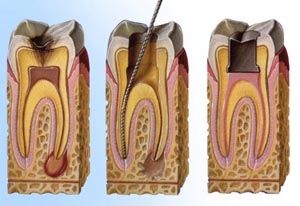Length of Treatment
 Treatment usually requires from one to three appointments. During these treatments, your dentist removes the diseased pulp. The pulp chamber and root canal(s) of the tooth are then cleaned, shaped, filled, and sealed to prevent recontamination of the root canal system. Root canal therapy usually is a relatively painless procedure. If your dentist anticipates that any special care is needed for successful treatment, he or she may refer you to a specialist called an Endodontist. Treatment usually requires from one to three appointments. During these treatments, your dentist removes the diseased pulp. The pulp chamber and root canal(s) of the tooth are then cleaned, shaped, filled, and sealed to prevent recontamination of the root canal system. Root canal therapy usually is a relatively painless procedure. If your dentist anticipates that any special care is needed for successful treatment, he or she may refer you to a specialist called an Endodontist.
The pulp is a soft tissue that contains the nerves, arteries, veins, and lymph vessels of a tooth. It lies within the dentin, the bone-like tissue that supports the enamel. Within the dentin, the pulp extends from the pulp chamber in the crown (the portion of the tooth visible above the gums) down to the tip of the root by way of the root canal. All teeth have only one pulp chamber, but teeth with more than one root will have more than one canal.
(Back to top)
|